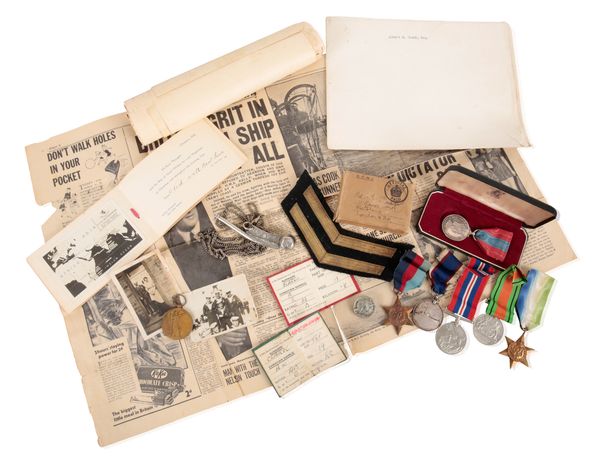| Estimate: | £150 - £250 |
| Hammer price: | £320 |
1939/45 Star
Atlantic Star
Defence Medal
War Medal
LSGC = J/87432 CH, B22521 A E Clark AB (official correction to ‘ar’ in Clark),
Imperial Service Medal = Albert Edward Clark
Condition GVF
Albert Edward Clark was born in Tottenham, London in 1902. He joined the Royal Navy in April 1918.
He joined HMS Kelly just as she was leaving the dry dock. Kelly was involved in one of the most famous actions of WW2. Captained by Louis Mountbatten, she took part in the battle of Norway in 1940. On the night of 9th / 10th May, she was torpedoed by E Boat S31. Due to the damage inflicted, Kelly was unable to operate under her own steam. She was towed back to Port by the tug Great Emperor. During the journey, which took four days, the ship was repeatedly attacked by E boats and by the Luftwaffe.
The film ‘In Which We Serve’ starring Noel Coward was based on the story of HMS Kelly.
It seems that Clark was possibly wounded during the action as he never again served on board a ship or a shore establishment. After leaving the Kelly, the next entry on his papers shows he was discharged on 8th January 1944. Which accounts for his Loyal Service badge.
For his service during WW2, he was awarded the 1939 to 45 Star, Atlantic Star, Defence Medal and end of War. The medals are in their original box with entailment slip. He was also awarded the Fleet reserve LSGC and a EII Imperial Service Medal, which comes with award certificate and box.
The group comes with a number of photographs once showing him wearing a Bosnian whistle which is present with the group, pass for HMS Kelly. Three Neptune scrolls named to Clark are also included.
A reformed character to get the LSGC, he was imprisoned for being AWOL in 1921 and punished in 1926, having his wages forfeited!
The following report by Lord Louis Mountbatten, Captain (D); 5th Destroyer Flotilla, was submitted to the Admiralty on the 20th May 1940:
“I had to decide how long to remain hunting this submarine without prejudicing my chance of rejoining the BIRMINGHAM before she made contact with the enemy. I knew from the aircraft sighting report that we were very near the position of this submarine and felt she should be destroyed if time permitted. When, however, at 2018/9 [9th May] an enemy report of four minelayers, three destroyers and one torpedo boat was received from aircraft, I immediately proceeded with the KANDAHAR at 32 knots to rejoin the BIRMINGHAM, who was only just in sight on the horizon and signalled that she had increased to 28 knots. At 2050/9 a destroyer was sighted on the horizon. She turned out to be the BULLDOG, who requested permission to join me, having lost her own force to the Northward after being ordered to sink a floating mine. She came in astern and was endeavouring to catch up. At 2052/9 a Dornier was sighted and fire opened.
8. The visibility was fairly good to the Eastward and very good to the Westward, but hazy to the Northward. At about 2230/9 the visibility to port (i.e. to the Northward) became very bad, a bank of mist having formed. At 2242 I ordered speed to be reduced from 32 to 28 knots to allow the BULLDOG to catch up. At 2244 a blurred object was sighted by a number (including myself), about three to four cables on the port beam in the mist, and almost simultaneously I saw the track of a torpedo pass under the bridge.
9. After an appreciable delay the torpedo exploded and the ship took up a list of some 12 to 13 degrees to starboard. Details of the damage and the immediate steps which were taken to control it are given in Appendix I.
10. With the flames, smoke and escaping steam nothing more was seen of our assailant, nor of the KANDAHAR, who had been close astern. The BULLDOG, however, had been a mile astern and soon appeared in the gloom. I ordered her to drop depth charges to the Northward, being uncertain at this time in my own mind whether our assailant had beena submarine or a Motor Torpedo Boat. I later established beyond doubt that it was at least one, if not two, Motor Torpedo Boats, and since they were never in sight until after they had fired I feel sure that the Dornier we had been firing at had been directing them behind the fog bank by W/T.
11. The BULLDOG obtained a good contact and fired a pattern, after which she returned to our aid. At this moment a large vessel appeared out of the fog at high speed, and just missed the BULLDOG. It is presumed that this was the BIRMINGHAM, as she made the “VF” reply on passing.
12. The BULLDOG proceeded to take me in tow in the fog which had now become very thick. I consider that the handling of the BULLDOG was a supreme display of seamanship and ship-handling, in that she had the KELLY in tow and was proceeding ahead by 2340/9 less than one hour after the explosion and during which she had carried out a submarine hunt. (For this I consider the greatest credit to be due to her Commanding 0fficer, Lieutenant Commander J.P. Wisden).
13. With an excessive bow trim and heavy list, and with the starboard gunwhale awash the KELLY was extremely cumbersome in tow but it was possible to bring hand steering into use, which was of some slight help. HMS Kelly under tow in the North Sea, as seen by one of the Coastal Command aircraft that went to her assistance 11th May 1940
14. At about 0010/10 [10th May] the noise of a powerful internal combustion engine was heard, and almost immediately a very large white Motor Torpedo Boat appeared out of the fog
and rammed the BULLDOG’s starboard quarter. She then opened fire with a small pom-pom or large machine gun, but was evidently out of control as she next rammed the KELLY. She struck the KELLY at the break of the forecastle and charged down my starboard side, carrying away the whaler, motor boat and motor boat davits, and knocking guard-rails and the starboard torpedo davit overboard.
15. She left behind some parts of her hull and a large clip of ammunition which was handed to the Admiralty Constructive Officer who inspected the ship on her arrival at the Tyne. Her engine was heard to stop, then splutter and finally die out, and although the fog was so dense that she could not be seen, she must certainly have sunk.
16. Sometime later the noise of another Motor Torpedo Boat was heard in the fog. We all expected that this second Motor Torpedo Boat would be able to get the KELLY since it was clear that she would be able to sight me first in the fog, but I had machine guns and pom-pom manned in readiness. Fortunately, however, she disappeared without sighting the KELLY.
17. The tow consisted of the BULLDOG’s 3 1/2inch wire and two shackles of the KELLY’s cable. By skilful handling the BULLDOG succeeded in making Westing clear of the danger zone at about 6 knots.
18. At 0310/10 the KANDAHAR appeared by herself and at 0430/10 I stopped to allow her to put her starboard quarter alongside the KELLY’s starboard quarter and take off my wounded and those men (chiefly of the engine room and wireless departments) who would not be required for fighting the ship, since all machinery was out of action. With no lighting or heating arrangements and a shortage of water and with the sick bay wrecked, the facilities for attending to the more seriously wounded on board the KELLY were not good.
19. During the transfer of the wounded the first German aircraft appeared and all guns were in action in both ships as the wounded were carried over.
The air escort of three Hudsons arrived just in time to drive off the aircraft. A little later the BIRMINGHAM and destroyers joined escort us, but after about two hours they parted company and I was left with the KANDAHAR, FURY, GALLANT and BULLDOG.
After further attacks by enemy aircraft HMS Kelly finally made the Tyne on 13th May 1940 after 91 hours under tow”. Signed: Louis Mountbatten, Captain (D); 5th Destroyer Flotilla.



